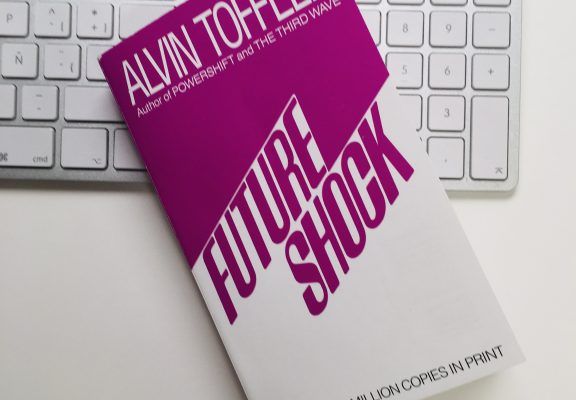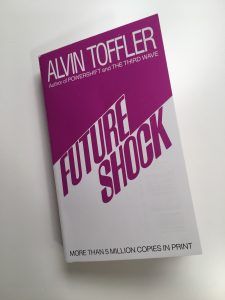

Future Shock, by Alvin Toffler
The origins of coolhunting

| Nº of pages: | 560 |
| Publisher: | Bantam Books |
| Language: | English |
| ISBN: | 9780553277371 |
| Year of publication: | 1990 |
| Year of original publication: | 1970 |
| Place of publication: | New York |
| Where to buy: | Amazon |
In two sentences:
"In a society in which instant food, instant education and even instant cities are everyday phenomena, no product is more swiftly fabricated or more ruthlessly destroyed than the instant celebrity" (1970) "Machines and men both, instead of being concentrated in gigantic factories and Factory cities, will be scattered across the globe, linked together by amazingly sensitive, near instantaneous communication" (1970)
In less than 500 characters:
This text, written in 1970, is one of the most prominent among the wealth of texts predicting the future that appeared in the early 1970s.
The book proposes a journey through the main predictions of change, structured around the topics that were of most concern to people at the time and to the author himself: manufacturing, communication, mobility… and drag queens.
Why I should read it:
This text proposes an inspirational journey through the future, as some essayists saw it 50 years ago. It is very revealing to wander through its pages (even better if you have a paperback which leaves traces of ink on your hands and brings back memories of cheap editions) and revel in the vision it presents of how the author thought we would live today.
Regardless of the predictions that were right or wrong, this book has had enormous influence, being one of the first to introduce concepts such as the internet, social networks, diversity and sustainability.
The chapters were published separately in magazines and other media, and not put together until the end. By a curious coincidence, this gives the book a similar narrative structure to the science fiction novels of the time, which the author criticizes somewhat arrogantly.
6 Stimulating ideas:
- This book should not be read for its content. It is more interesting and stimulating to read it looking for the differences between what Toffler proposes and what has ended up happening. It is particularly intriguing to think about the factors that led to the divergence.
- Although it is a text published in 1970, the author talks about insights, segmentation and innovation in the same way as multinational managers do today. The next time you hear someone using a “new” word, you can assume it’s probably in this book.
- The book is long and aims to cover the issues that concerned the readers of progressive male magazines, where most of the chapters appeared. This point of view contrasts with what the author’s contemporaries did in France and Germany, where they applied a more academic, less popular approach.
- The way in which the author talks about the idea of change, evolution, revolution and adaptation helps to give depth to these concepts in the way we currently use them.
- The book really shines in its veiled criticism of some of the topics it presents. Although it appears to be progressive and liberal, there are moments when clearly misogynistic, homophobic or xenophobic attitudes can be detected. It is a product of its time and must be read as such, although, from the contemporary viewpoint, there are phrases that are totally obsolete in what is supposed to be a futuristic text.
- For those interested in Future Studies, the notes to the text and, especially, the bibliography at the end are of considerable interest. The author of this article is an enthusiast of this subject and was unfamiliar with more than half of the texts referred to.
If you like this text, you might also like:
- The Third Wave (the sequel to this book, also by Alvin Toffler)
- Une Brève Histoire de l’Image (Michel Melot)